|
|
|
Sort Order |
|
|
|
Items / Page
|
|
|
|
|
|
|
| Srl | Item |
| 1 |
ID:
192165
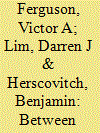

|
|
|
|
|
| Summary/Abstract |
For nearly four decades, Australia’s domestic and international economic policies were anchored by the promotion of open, transparent, and rules-based market exchange. This was considered the best way to increase both Australia’s prosperity and its security, and that belief guided Canberra’s approach to economic statecraft. However, emerging concerns about the vulnerabilities arising from economic interdependence, and the increasingly blurry line between economics and security amid great power rivalry between China and the United States, have placed Australian policy orthodoxy in a difficult position. In this paper, we investigate how these dynamics are shaping change and continuity in Australia’s economic statecraft, and in doing so offer three contributions. First, to advance the emerging comparative economic statecraft research agenda, we propose a modified concept of economic statecraft that captures a wider range of activities undertaken by non-great powers and a distinction between state-based and market-based actions which allows for within- and cross-case comparisons. Second, empirically, we sketch the historical evolution of Australia’s approach and examine three salient domains in which it has recently pursued new economic statecraft initiatives. Finally, in evaluating recent change and continuity, our third contribution is to identify new variables that may illuminate the conditions under which states adapt their prevailing approach to economic statecraft.
|
|
|
|
|
|
|
|
|
|
|
|
|
|
|
|
| 2 |
ID:
192158
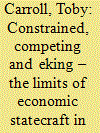

|
|
|
|
|
| Summary/Abstract |
This paper highlights the highly contingent and constrained possibilities for states concerned with gaining and maintaining economic and, relatedly, strategic advantage in East Asia in a world dominated by global value chains (GVCs) owned and controlled by transnational capital. While the reorganisation of production has given rise to new contender states such as China, challenging the economic and strategic positions of others, the ability for states to engage in non-market conforming behaviour designed to reduce technological dependence, accumulate reserves and embolden national positions against competitors is far more constrained than it once was. Prioritising the relative power and leverage of states operating in various contexts over time, three types of state are identified within contemporary East Asia: former developmental states under persistent competitive pressures compelling very different policy agendas to those that underpinned their respective development stories; a somewhat exceptional constrained “aspirant state”, attempting mercantilist strategies to achieve strategic upgrading under the spectre of systemic exclusion and formidable domestic challenges; and, finally, relatively vulnerable “eke-out” competition states, attempting to leverage labour cost, geography and regulation to maintain economic relevance within the context of hyper competitiveness while also engaging in forms of quarantining and patronage. Our overarching argument is that the latitude to both pursue and leverage ES strategies common in the past is all but gone, even for the most powerful of contender states.
|
|
|
|
|
|
|
|
|
|
|
|
|
|
|
|
| 3 |
ID:
192157
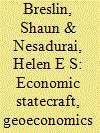

|
|
|
|
|
| Summary/Abstract |
In this introduction to the special issue, we establish the overarching objective for the collection; to investigate the salience and efficacy of conceptions of Economic Statecraft (ES) and Geoeconomics for understanding and explaining shifts in state-market relationships in a number of regional political economies. After a very short overview of different generations of ES research, we establish the set of common questions that each of the papers address, and how we arrived at them as the research project evolved. We point to the importance of ensuring that ES is not just thought of as something that the more powerful regional states engage in, and the need to adopt a three-part analytical distinction between different components of ES: motivations and objectives; actions and tools; and outcomes and consequences. This allows us to trace the relationship between goals and effects, provides a basis for comparative studies, and makes it easier to make a distinction between ES and other forms of state involvement in the economy.
|
|
|
|
|
|
|
|
|
|
|
|
|
|
|
|
| 4 |
ID:
192162
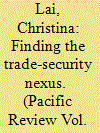

|
|
|
|
|
| Summary/Abstract |
Over the last few decades, China has become one of the most important foreign investment destinations and centers of economic development in Asia. China’s growing economic clout and coercive measures lead to the following empirical puzzles: how has Taiwan perceived China’s increasing military capabilities and economic influence? What are the major factors that facilitate or constrain the role of a government agency of a weaker state in addressing the economic power of a stronger one? More specifically, what has been the purpose of Taiwan’s economic statecraft? Based on Taiwan’s official statements, regional trade data, and newspaper coverage in Chinese and English, this study investigates both positive and negative evaluations of China-Taiwan trade from 2009 to 2021. From 2009 to 2016, President Ma Ying-jeou adopted a desecuritization strategy in normalizing bilateral trade with China, and he actively promoted greater liberalization of Taiwan’s financial and service sectors for China’s investment. From 2016 to 2021, President Tsai Ing-wen employed a securitization strategy in light of the risks of economic reliance on China’s markets. The article proceeds as follows. First, it engages the current literature on economic statecraft, China-Taiwan relations, and Asian politics. Second, this study offers a framework of desecuritization and securitization of Taiwan’s trade toward China, and it highlights how the political leaders in Taiwan attempt to find a balance between trade and security. Third, it provides in-depth case studies on how Taiwan executed desecuritization and securitization strategies. Finally, it concludes with some initial thoughts on the studies of comparative economic statecraft, and provides policy implications for countries in the Asia Pacific region and beyond.
|
|
|
|
|
|
|
|
|
|
|
|
|
|
|
|
| 5 |
ID:
192159


|
|
|
|
|
| Summary/Abstract |
Interest and anxiety about China’s economic statecraft, or the ways in which it uses economic means to achieve foreign policy, is booming. The overriding perception is that China has sophisticated, long-term plans to enhance its power on the global stage through the use of economic strategies and tools and that it is uniquely capable of effectively implementing those plans now or in the future. Yet when it comes to actual outcomes, whether or not China has been able to achieve its foreign policy goals via economic means, the evidence is mixed at best. This article seeks to move beyond some of the shortcomings in our understanding of Chinese economic statecraft by exploring the links between perceptions, ambitions, abilities, and outcomes of Chinese foreign economic policies and behaviour. We propose an alternative to the concept of economic statecraft by introducing instead five different ‘modes of economic influence’. We suggest directions for future research focused on China’s economic influence, including its latent structural power.
|
|
|
|
|
|
|
|
|
|
|
|
|
|
|
|
| 6 |
ID:
192163


|
|
|
|
|
| Summary/Abstract |
Indonesia is a net debtor country, meaning typically more investment flows into Indonesia than goes out. This is an important driver of growth, but can also create strategic and economic liabilities as foreign creditors establish claims on Indonesian assets. This paper uses the concept of defensive economic statecraft to explain how the Indonesian state has taken actions to mitigate these vulnerabilities by deepening domestic capital markets, accumulating foreign exchange reserves, intermediating inflows through SOEs and forcing investment into strategic sectors. Although foreign investment involves risks and trade-offs, this paper analyzes some of the mechanisms by which net debtor countries like Indonesia can mitigate such risks.
|
|
|
|
|
|
|
|
|
|
|
|
|
|
|
|
| 7 |
ID:
192164
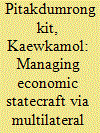

|
|
|
|
|
| Summary/Abstract |
Economic statecraft (ES) has been playing an increased role in affecting the international relations. While armed conflicts decline, states have been weaponising trade, investment, and other economic ties to gain leverage over their counterparts. In the contemporary world, ES is not only used to galvanise countries’ influence in specific issue areas but also part of their grand strategy to achieve broad power-maximisation goals. Despite a proliferation of ES literatures in recent years, extant research tended to focus on great powers’ ES, leaving small states’ ES under-examined. Also, previous studies usually looked into how countries unilaterally employ ES. Hence, insufficient attention has been paid to how regional states work together to collectively alter multilateral frameworks to advance their ES. Against this backdrop, this paper investigates small nations’ roles in the development of multilateral cooperative frameworks. Using the ES lens, it explores how these countries leverage these schemes to push forward their collective ES. The main argument is that regional states worked together to craft the terms of multilateral economic agreements to galvanise their clout over certain governance areas. I validate this argument by using the case of Regional Comprehensive Economic Partnership (RCEP). This study makes contributions to the research pertaining to ES, small states’ strategies, and economic regionalism. It also yields practical implications for policymakers involved in fostering international economic governance.
|
|
|
|
|
|
|
|
|
|
|
|
|
|
|
|
| 8 |
ID:
192160
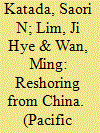

|
|
|
|
|
| Summary/Abstract |
This article examines the Japanese and South Korean governments’ reshoring and diversification policies of supply chains especially away from China since the early 2010s, with particular attention to the measures taken under the 2020–21 pandemic. The article also explores how much Japanese and South Korean reshoring from China, a subset of foreign economic policy, counts as economic statecraft as a deliberate government attempt to achieve geopolitical objectives using ‘economic’ means. One would expect these governments, which innovated proactive industrial policies and guided the private sector to catch up with developed economies in the 20th century, to have an easy time encouraging businesses to re-shore. While these two governments have employed various policy instruments to shift their economic dependence away from China, there is only limited success in motivating businesses to return to their homeland. This leads to an intriguing departure in our understanding of the capacity of those two Asian nations, which used to be considered prototypical ‘developmental states’ where governments have significant influence over business behaviour. This research brings more nuance and complexity to prevailing state-as-unitary-actor assumption of the economic statecraft literature and advocates closer attention to domestic sources of foreign economic policy.
|
|
|
|
|
|
|
|
|
|
|
|
|
|
|
|
| 9 |
ID:
192161


|
|
|
|
|
| Summary/Abstract |
As clean energy policy becomes a pressing need in the wake of the looming climate crisis, the world—especially developing Asia—has witnessed a conflicting trend throughout the 2010s, that is, the boom of coal-fired power development. This article argues that the geoeconomic significance, driven by not only China’s but also Japan and South Korea’s pursuit of national interests, intensified a competition among them in supporting overseas coal fired power financing and has contributed to this phenomenon. Using a mix of qualitative and quantitative data, it illustrates that while coal power financing becomes a conduit for these three ‘developmental states’ to forge comprehensive relations with countries they deem strategically important, the effectiveness of using this conduit is contingent, and constrained by exogenous factors, particularly dynamics of global energy markets.
|
|
|
|
|
|
|
|
|
|
|
|
|
|
|
|
|
|
|
|
|